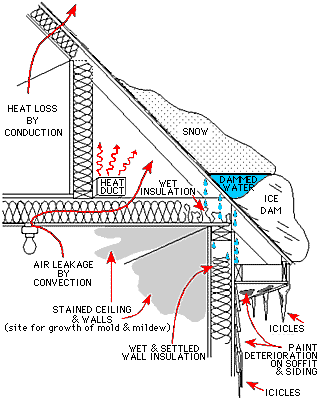Ice Dam Information
Many Twin Cities area homes had ice dams building on the edges of their roofs this winter. If your house had this problem and you’re wondering what to do about it, here’s an article that explains how ice dams form and the key issues in solving an ice dam problem.
An Ice Dam Compromise

Cross section of a one-and-a-half story house with an ice dam. Graphic courtesy of University of Minnesota Extension.
We discovered our home’s ice dam problem the winter I used a corner of our second floor as an office. It was always cold up there in the winter, so I left the door open at the foot of the stairs. Previously, we had kept this door closed and used our second floor–with its 1950s styling–for storage.
Those few extra degrees of heat, coupled with the right weather conditions, were all it took to produce ice dams on both sides of the roof. I ran out to buy a snow rake. Thankfully, the fourth store I visited still had one, so I returned home saying, “Honey, I solved this problem!” Well, not quite. Those ice dams lasted until spring.
Clearly, more drastic measures were needed. So, we became more serious about remodeling our second floor, figuring it would provide the opportunity to solve the ice dam situation and give us the improved living space we wanted.
A year later when our contractor peeled away the knee walls and ceiling of our second floor we discovered the reasons why we had an ice dam problem. The 2 x 4 rafters were packed tight with insulation, and so were the vents in the eaves. It was a classic recipe for ice dams: too little insulation and very little air circulation under the roof deck to keep it cool.
If you’re not quite sure why this is important, here’s why. Ice dams form when the upper portions of a roof heat up under a blanket of snow. The melt water flows down the slope and re-freezes on the roof over the cooler eaves. Gradually an ice dam builds, trapping water behind it. The trapped water seeps under the shingles to leak into the home, damaging insulation, walls, and ceilings.
Solving the ice dam problem involves keeping the roof cool. Unfortunately, many older homes don’t have enough insulation or there are gaps in the insulation–usually around light fixtures, flue pipes, and chimneys. Basically, anything that penetrates the cavity between the rafters can create a leak that lets warm air reach the roof and cause the snow to melt. Sealing those leaks is the first, best step toward eliminating ice dams.
Our story-and-a-half bungalow presented a few challenges, but we had the advantage of gutting the upper floor and installing a new insulation and ventilation design. While this may not be possible for everyone, what we did might give you some insight toward solving your ice dam situation.
The only way–short of a new roof with 2 x 10 rafters that we couldn’t afford–to install enough insulation under our roof was to repack the rafter cavities with insulation and add another four inches of rigid insulation over the face of the rafters. Since this would have further reduced our already short ceiling height, we kept looking for another idea.
What we found was a compromise. We form-fitted the rafter cavities with rigid insulation, but left a channel next to the roof boards for cool air to circulate between the eaves and our new ridge vent. These sheets of insulation went over the tops of the knee walls and the plate above the outside walls. Then we covered the face of the rafters with insulation that included a continuous air barrier to keep the warm air inside. We pushed the contractor to carefully seal the barrier around everything that had to punch through the barrier.
Our solution didn’t give us all the R-value you’re supposed to have in roof insulation, but we figure the air barrier and improved natural ventilation will compensate. So far, it’s worked beautifully because we’re now heating the second floor and haven’t had any ice dams.
Solving ice dam problems is complex. There are some not so good ideas, such as installing mechanical ventilation in your attic or heat coils on the edge of your roof. We consulted with residential energy efficiency experts at the University of Minnesota. There are several reputable sources of information. On the Internet you can download an ice dam publication from University of Minnesota Extension at www.extension.umn.edu/
The Minnesota Department of Commerce also has ice dam information at www.state.mn.us. Enter “ice dams” in the search box.
Marty Moen and his wife, Gail Tischler, own a bungalow in the Macalester-Groveland neighborhood of St. Paul.











